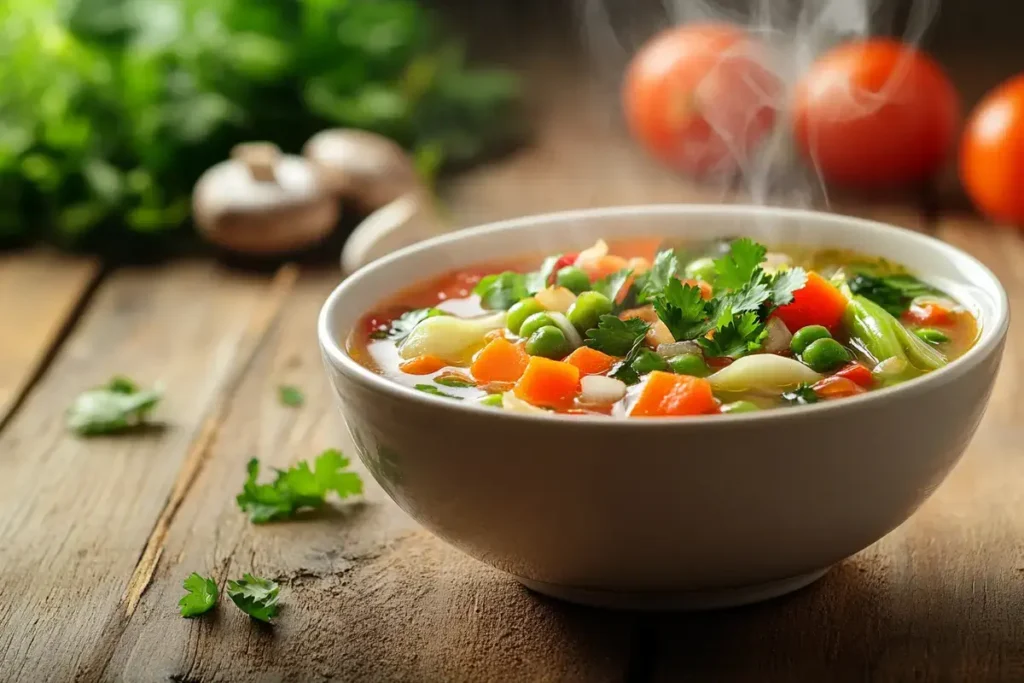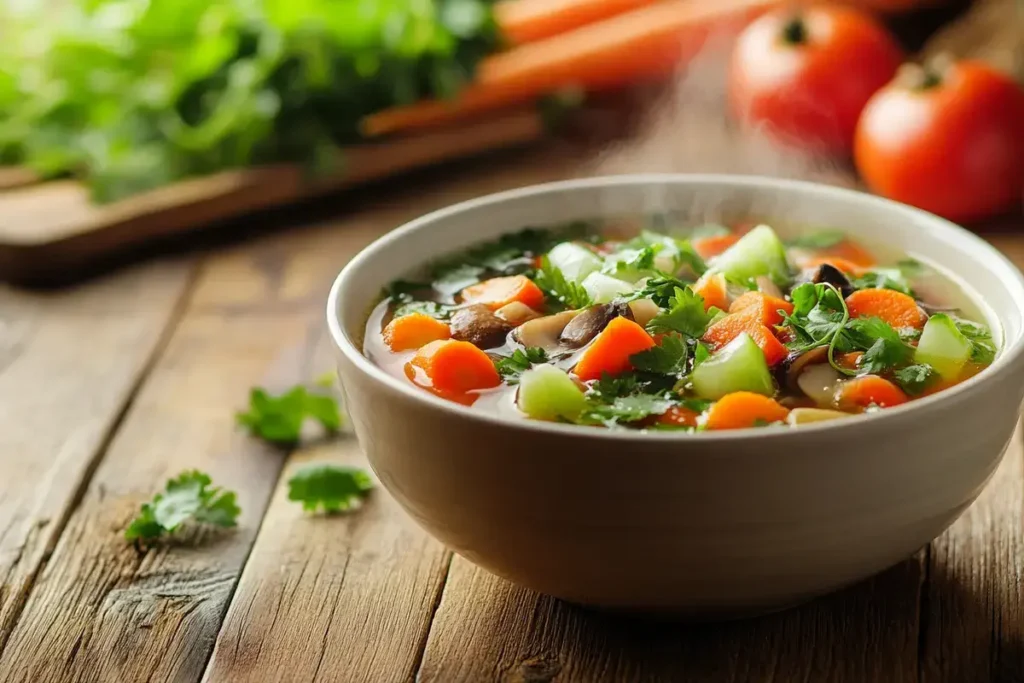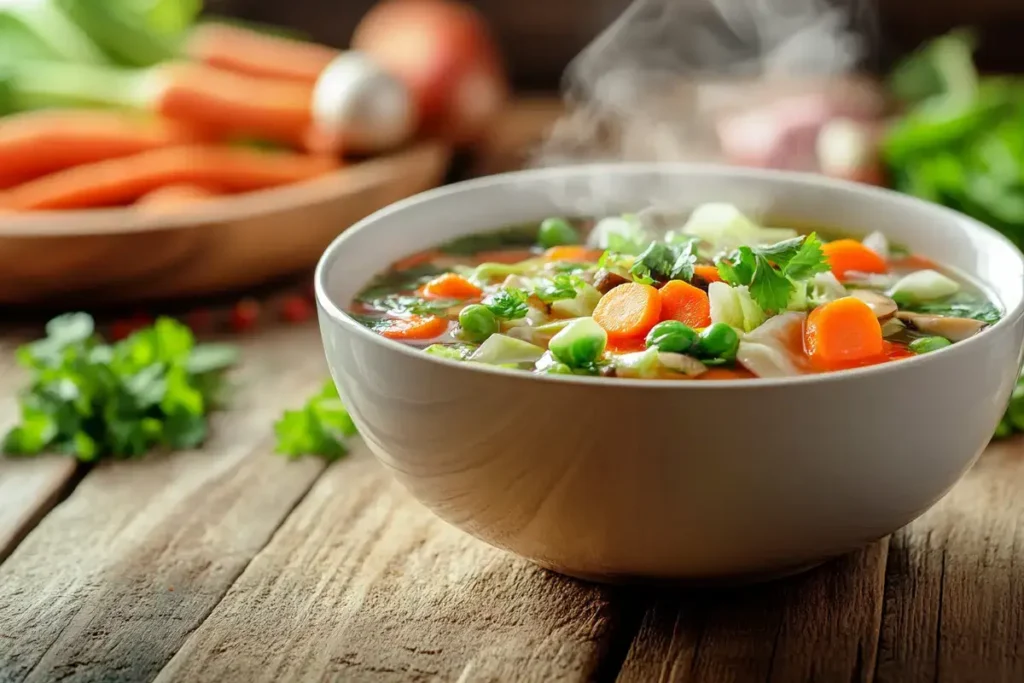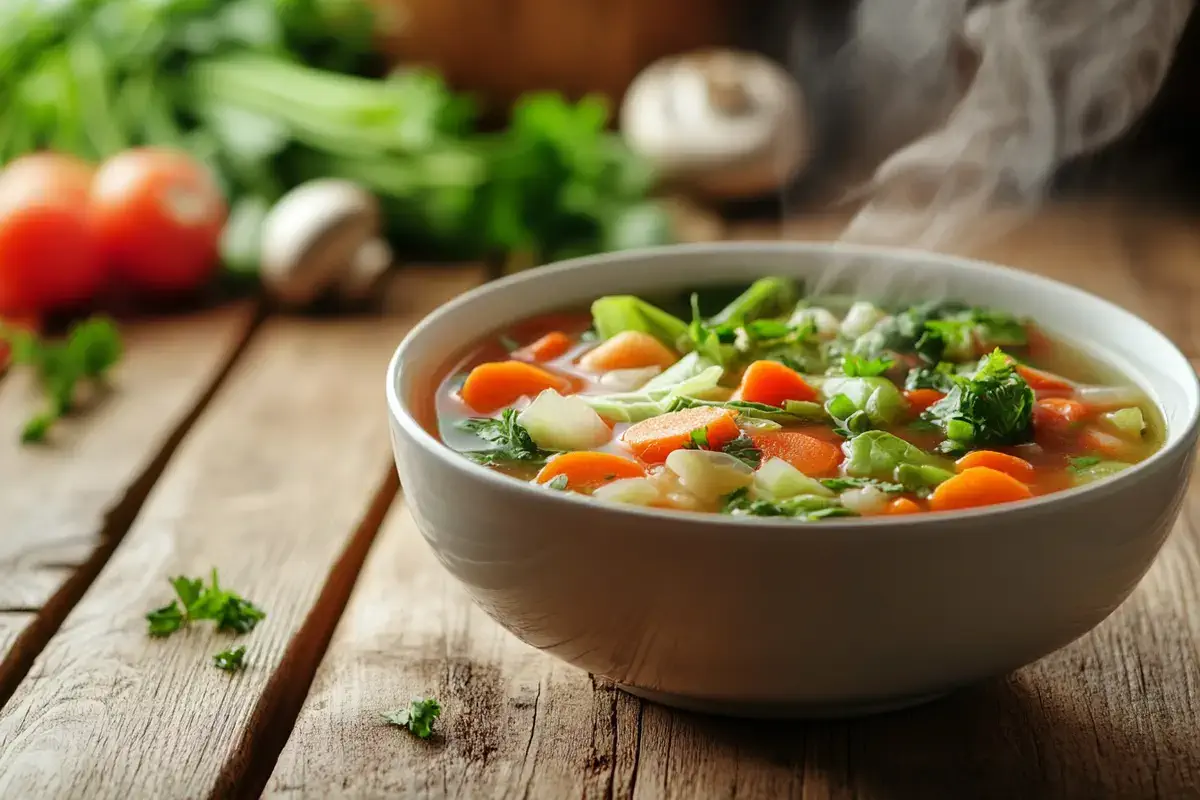Vietnamese vegetarian soup is a gateway to the rich and vibrant culinary traditions of Vietnam. Known for its delicate balance of flavors, this type of soup embodies the essence of Vietnamese cuisine, simple yet profoundly satisfying. From the tangy kick of tamarind in Canh Chua Chay to the soothing warmth of a vegetable-infused Pho Chay, these soups showcase the diversity of ingredients and techniques that define the region’s food culture.
Rooted in centuries of tradition, Vietnamese soups hold a cherished place in family meals and special occasions alike. While many classic versions incorporate meat, the growing interest in plant-based diets has led to creative and equally delicious vegetarian adaptations. These soups rely on fresh vegetables, fragrant herbs, and carefully crafted broths to deliver a symphony of taste in every spoonful.
Whether you’re a seasoned chef or a home cook exploring international cuisine, mastering Vietnamese vegetarian soup opens up a world of possibilities. These soups are more than just meals, they are an experience, offering a blend of health, flavor, and cultural heritage that’s hard to resist.
Exploring the World of Vietnamese Vegetarian Soup
An Introduction to the Flavors of Vietnam
Vietnamese cuisine is a celebration of balance, with flavors carefully crafted to deliver harmony between sweet, sour, salty, and umami profiles. Central to this culinary tradition are soups, which serve as versatile dishes consumed across all meals. While meat-based options like pho bo (beef pho) are globally recognized, the rise of Vietnamese vegetarian soup offers a lighter, healthier alternative that maintains the essence of traditional flavors.
This vibrant cuisine places a significant emphasis on using fresh ingredients, aromatic herbs, and nutrient-rich vegetables. Such elements combine to produce hearty, flavorful soups that cater to vegetarian and vegan preferences. For instance, dishes like vegetarian pho highlight how plant-based versions can preserve authenticity while introducing creative variations.
The Rise of Vietnamese Vegetarian Soups
As vegetarian and vegan diets gain popularity worldwide, so too has the demand for plant-based versions of iconic dishes. In Vietnam, soups are more than just food—they’re a cultural institution. The shift toward vegetarian adaptations reflects not only changing preferences but also the adaptability of Vietnamese culinary practices. Soups like Pho Chay and Canh Chua Chay stand out as beloved staples that deliver on both taste and nutrition.
Incorporating these recipes into your diet can be incredibly rewarding. For an in-depth look at how to create flavorful vegetarian pho at home, check out this Vegan Soup Recipe, which offers an easy-to-follow guide for a restaurant-quality dish.
Cultural Significance of Vietnamese Vegetarian Soup
Vietnamese meals often start or end with soup, symbolizing comfort and togetherness. The ingredients tell a story of regional diversity and respect for nature. Whether it’s the tamarind-infused tang of Canh Chua Chay or the delicate umami in Bún Riêu Chay, each soup reflects a unique aspect of Vietnam’s culinary identity.
Why Choose Vietnamese Vegetarian Soup?
Health Benefits
- Low in fat and calories but rich in nutrients.
- Packed with fresh vegetables, tofu, and herbs.
- Offers a satisfying alternative to heavy, meat-based dishes.
Versatility
- Can be served as a light appetizer or a hearty main course.
- Easily customizable with available ingredients and preferred spice levels.
Rich in Flavor
- Maintains the authentic taste profile of Vietnamese cuisine.
- Relies on carefully balanced broths, spices, and charred aromatics.
Common Ingredients in Vietnamese Vegetarian Soups
Key Vegetables
- Carrots, radishes, and onions for sweetness.
- Tomatoes, pineapple, and tamarind for acidity.
Protein Options
- Tofu: A staple in vegetarian and vegan dishes.
- Mushrooms: Adds depth and a meaty texture.
Aromatic Herbs
- Thai basil, cilantro, mint, and green onions enhance freshness.
- Lime wedges and chili provide customizable flavor bursts.
Signature Dishes to Try
Pho Chay (Vegetarian Pho)
- Features rice noodles in a fragrant vegetable broth.
- Garnished with tofu, bean sprouts, and fresh herbs.
- A classic take on comfort food.
Canh Chua Chay (Vegetarian Sour Soup)
- Combines tangy tamarind with sweet pineapple and okra.
- A vibrant dish ideal for warmer months.
Bún Riêu Chay (Vegetarian Tomato Noodle Soup)
- Tomato-based broth with rice vermicelli and tofu.
- Known for its rich, tangy flavor.
Conclusion: A Bowl Full of Culture and Nutrition
Vietnamese vegetarian soup represents more than a dietary choice; it’s a gateway to the country’s culinary traditions. With a focus on fresh, wholesome ingredients and a balance of complex flavors, these soups are perfect for those seeking healthful and delicious meals. Whether you’re drawn to the comforting warmth of Pho Chay or the tangy allure of Canh Chua Chay, these dishes invite you to explore the vibrant world of Vietnamese cuisine.
Popular Varieties of Vietnamese Vegetarian Soup

Exploring the Best Vietnamese Vegetarian Soups
The world of Vietnamese vegetarian soup is as diverse as it is flavorful. Each recipe showcases regional influences, vibrant ingredients, and time-honored techniques that make Vietnamese cuisine so unique. Below, we delve into the most popular types of vegetarian soups and what makes them stand out.
Pho Chay (Vegetarian Pho)
The Plant-Based Take on a National Classic
Pho Chay is a vegetarian rendition of Vietnam’s most famous soup, pho. This dish features:
- Rice noodles swimming in a fragrant vegetable broth.
- Tofu and mushrooms as plant-based protein options.
- Fresh herbs like cilantro, Thai basil, and green onions for garnish.
Canh Chua Chay (Vegetarian Sour Soup)
A Perfect Balance of Sweet and Sour
Canh Chua Chay is known for its tangy and vibrant flavor profile. Key ingredients include:
- Tamarind and pineapple for a sweet-sour base.
- Tomatoes, okra, and bean sprouts to enhance texture and flavor.
Ideal for Warmer Weather
This refreshing soup is a favorite during hot seasons. Its light, zesty broth offers a pleasant contrast to heavier meals. Discover how to recreate this classic at home with this guide to Vietnamese Vegetarian Sour Soup.
Bún Riêu Chay (Vegetarian Tomato Noodle Soup)
A Tangy, Tomato-Based Delight
This soup is celebrated for its vibrant red broth, achieved by simmering:
- Ripe tomatoes with a blend of spices.
- Tofu and mushrooms for a hearty yet vegetarian twist.
- Rice vermicelli as the noodle of choice.
How to Serve Bún Riêu Chay
Garnish with fresh herbs and a drizzle of chili oil for added depth. Explore an authentic recipe for this tangy dish in Vegan Vietnamese Sweet Soup Recipe.
Mì Quảng Chay (Vegetarian Quang Noodle Soup)
A Central Vietnamese Treasure
Hailing from central Vietnam, Mì Quảng Chay is known for its golden hue, derived from turmeric-infused noodles. Its components include:
- A flavorful broth made with mushrooms, tofu, and peanuts.
- Fresh herbs and crispy rice crackers for added texture.
Ingredients That Define Vietnamese Vegetarian Soup
Vegetables and Aromatics
- Carrots, daikon, and onions provide sweetness.
- Tomatoes and tamarind contribute acidity.
Protein Options
- Tofu serves as a versatile base for many soups.
- Mushrooms offer umami and a hearty texture.
Essential Herbs and Spices
- Thai basil, cilantro, and mint elevate the broth.
- Star anise, cinnamon, and cloves create depth.
Techniques for Authentic Vietnamese Vegetarian Soup
Mastering the Broth
A rich, flavorful broth is the heart of every soup. Achieving this involves:
- Simmering vegetables with charred aromatics for depth.
- Balancing sweet, sour, salty, and umami flavors.
Layering Flavors
The beauty of Vietnamese cuisine lies in its meticulous layering of tastes:
- Start with a strong base of herbs and spices.
- Add vegetables and tofu gradually to build complexity.
Personalizing Soups
No two bowls need to be the same. Adjust spice levels, swap out vegetables, or experiment with garnishes to suit your preferences.
Health Benefits of Vietnamese Vegetarian Soups
Nutritional Powerhouses
- Low in calories yet rich in vitamins and minerals.
- Packed with fiber from vegetables and noodles.
Hydration and Detoxification
- Soups with high water content help maintain hydration.
- Fresh herbs and vegetables support natural detox processes.
Serving and Storing Vietnamese Vegetarian Soup
Best Practices for Serving
- Serve soups fresh and hot for optimal flavor.
- Offer lime wedges, chili slices, and herbs on the side for customization.
Storing for Later
- Store broth and toppings separately to maintain texture.
- Refrigerate for up to three days or freeze for longer storage.
Embracing Vietnamese Vegetarian Soup in Everyday Life
With its rich flavors and health benefits, Vietnamese vegetarian soup is a welcome addition to any meal plan. Whether you’re enjoying the tangy allure of Canh Chua Chay or the comforting warmth of Pho Chay, these soups offer a taste of Vietnam’s culinary soul. Experiment with different recipes and make them your own.
Techniques and Tips for Mastering Vietnamese Vegetarian Soup

Understanding the Core of Vietnamese Vegetarian Soup
At the heart of every great Vietnamese vegetarian soup is its broth. A well-made broth is the canvas upon which the vibrant ingredients shine. By mastering the techniques behind the broth and customizing your soups, you can recreate the authentic flavors of Vietnam in your kitchen.
Crafting the Perfect Broth
Building Layers of Flavor
The broth is the soul of any soup, and Vietnamese vegetarian soup is no exception. To create depth and complexity, follow these steps:
- Char your aromatics: Onions, ginger, and garlic can be charred to enhance their natural sweetness and add a smoky undertone.
- Simmer with balance: Use a mix of carrots, daikon radish, and mushrooms for sweetness, complemented by tamarind or lime for acidity.
Key Spices for Authenticity
- Star anise, cloves, and cinnamon provide the signature pho flavor.
- Black peppercorns add a mild kick, perfect for vegetarian variations.
Customizing Vietnamese Vegetarian Soup
Adjusting to Taste Preferences
The versatility of Vietnamese vegetarian soup allows for endless customization:
- Control spice levels by adding or omitting chili.
- Experiment with fresh herbs like Thai basil, mint, or cilantro to enhance fragrance.
Substituting Ingredients
If you can’t find traditional ingredients, substitutions can work just as well:
- Replace mushrooms with jackfruit for a unique texture.
- Use soy sauce or coconut aminos in place of fish sauce for vegan recipes.
Pairing and Serving Suggestions

Side Dishes to Complement Your Soup
Vietnamese vegetarian soup pairs beautifully with a variety of traditional sides:
- Fresh spring rolls filled with tofu, vermicelli, and herbs.
- Bánh mì (Vietnamese baguette sandwiches) featuring plant-based fillings.
Presentation Matters
- Serve soups in wide bowls to showcase the colorful garnishes.
- Provide accompaniments like lime wedges, chili slices, and bean sprouts for customization.
Common Mistakes to Avoid
Overloading Ingredients
Adding too many components can overwhelm the broth’s delicate flavors. Keep it simple to let the core ingredients shine.
Skipping the Simmering Step
Rushing the broth preparation leads to a less flavorful base. Patience is key to developing a rich, aromatic soup.
Benefits of Incorporating Vietnamese Vegetarian Soup in Your Diet
Health Boosts
- Rich in antioxidants from fresh herbs and vegetables.
- Low in saturated fats, making it heart-healthy.
Culinary Exploration
By experimenting with different Vietnamese vegetarian soups, you expand your palate and gain an appreciation for the nuanced flavors of this cuisine.
Conclusion: Bringing the Flavors Home
Mastering the techniques for making Vietnamese vegetarian soup allows you to experience the essence of Vietnamese cuisine from your own kitchen. By focusing on broth preparation, customizing ingredients, and presenting the soup with care, you can elevate this dish to its full potential. Whether it’s the warm embrace of Pho Chay or the tangy delight of Canh Chua Chay, these soups provide nourishment for both the body and soul. Explore, experiment, and enjoy the journey into Vietnam’s rich culinary traditions.

